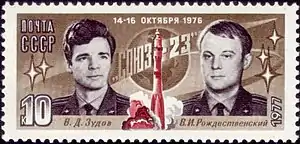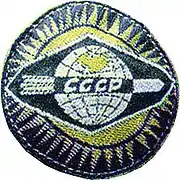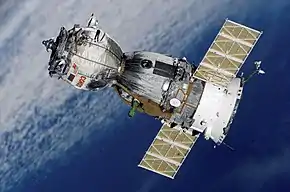Soyuz 23
Soyuz 23 (Russian: Союз 23, Union 23) was a 1976 Soviet crewed space flight, the second to the Salyut 5 space station. Cosmonauts Vyacheslav Zudov and Valery Rozhdestvensky arrived at the station, but an equipment malfunction did not allow docking and the mission had to be aborted.[4]
 Commemoration stamp of Vyacheslav Zudov and Valery Rozhdestvensky | |
| Operator | Soviet space program |
|---|---|
| COSPAR ID | 1976-100A |
| SATCAT no. | 09477 |
| Mission duration | 2 days 6 minutes 35 seconds |
| Orbits completed | 32 |
| Spacecraft properties | |
| Spacecraft | Soyuz 7K-T No.10 |
| Spacecraft type | Soyuz 7K-T/A9 |
| Manufacturer | NPO Energia |
| Launch mass | 6750 kg [1] |
| Landing mass | 1200 kg |
| Crew | |
| Crew size | 2 |
| Members | Vyacheslav Zudov Valery Rozhdestvensky |
| Callsign | Радон (Radon - "Radon") |
| Start of mission | |
| Launch date | 14 October 1976, 17:39:18 UTC |
| Rocket | Soyuz |
| Launch site | Baikonur, Site 1/5 [2] |
| End of mission | |
| Landing date | 16 October 1976, 17:45:53 UTC |
| Landing site | Lake Tengiz, Kazakhstan |
| Orbital parameters | |
| Reference system | Geocentric orbit [3] |
| Regime | Low Earth orbit |
| Perigee altitude | 243.0 km |
| Apogee altitude | 275.0 km |
| Inclination | 51.6° |
| Period | 89.5 minutes |
 Vimpel Diamond patch | |
The crew returned to Earth, but landed on partially frozen Lake Tengiz, the first splashdown in the Soviet space program. While there was no concern about any immediate threat to the crew, the capsule sank under the surface of the frozen lake, and recovery took nine hours owing to fog and other adverse conditions. The landing marked the only example of an unintentional splashdown of a crewed spacecraft to date.
Crew
| Position | Cosmonaut | |
|---|---|---|
| Commander | Only spaceflight | |
| Flight Engineer | Only spaceflight | |
Mission highlights
Soyuz 23 was launched 14 October 1976 with an estimated 73- to 85-day mission planned aboard the orbiting Salyut 5 space station.[5] Others suggest a 17- to 24-day mission was a more likely intention.[6] It was the first visit to the station after the sudden termination of the Soyuz 21 mission in August 1976. However, on 15 October 1976, during the automatic approach phase, the automatic docking system malfunctioned before the craft was within 100 metres of the station. Crews were normally trained for a manual dock, but not for a manual approach.[5] The mission, accordingly, had to be abandoned.
The craft had only two days of battery power, so systems were powered off, including the radio, to conserve power.[5] The day's landing opportunity had already passed, so they had to wait for the next day's landing opportunity near the Baikonur Cosmodrome. On 16 October 1976, Soyuz 23 returned to Earth and landed at 17:45:53 UTC, but weather conditions were poor and the cosmonauts experienced an unusual recovery. They landed on a freezing Lake Tengiz (average depth 2.5 m, max depth 6.7 m), at 8 km from shore, in the middle of a blizzard, with fog and temperatures at −22 °C.[5] It was the first water landing by a Soviet crew.[6] The capsule was designed to land in any conditions, even in a body of water, so the only concern was the increased difficulty in finding the capsule and crew.[5][7]
The parachute quickly sank beneath water and dragged the capsule and its crew beneath the surface; in addition an electrical short caused by the water impact caused the reserve parachute to accidentally deploy. The capsule cooled in the freezing water, and the cosmonauts removed their pressure suits and donned their normal flight suits, expecting a quick rescue. The parachutes became waterlogged and pulled the capsule onto its side, preventing the hatch from being opened. The transmission antennas were also under water, so the crew could not communicate with rescue teams. The capsule's beacons could not be seen in the heavy fog, and rubber rafts used to try to reach them were blocked by ice and sludge. Amphibious vehicles were airlifted to the vicinity, but could not reach the capsule owing to bogs surrounding the lake. Accordingly, the rescue was called off until dawn.[5] The cosmonauts were safe, but they were low on power, so they were forced to shut down everything but a small interior light.
The next morning, frogmen were dropped in by helicopters and attached flotation devices to the Soyuz craft. The capsule was too heavy to be lifted by the helicopter, so it was dragged to shore. The recovery operation had taken nine hours. No attempt was made to open the hatch as the recovery crews assumed the cosmonauts were dead, so they called for a special team to remove their bodies. Eventually, eleven hours after splashdown, the cosmonauts opened the hatch and emerged alive and well, if badly chilled (the interior of the descent module was coated with frost).[5]
Press releases by Soviet news agency TASS announced that there had been a water landing and that the cosmonauts were recovered safely, but made no mention of the rescue operation involved and the details of it were not revealed until the era of glasnost a decade later.
Mission parameters
References
- "Display: Soyuz 23 1976-100A". NASA. 14 May 2020. Retrieved 17 October 2020.
 This article incorporates text from this source, which is in the public domain.
This article incorporates text from this source, which is in the public domain. - "Baikonur LC1". Encyclopedia Astronautica. Retrieved 4 March 2009.
- "Trajectory: Soyuz 23 1976-100A". NASA. 14 May 2020. Retrieved 17 October 2020.
 This article incorporates text from this source, which is in the public domain.
This article incorporates text from this source, which is in the public domain. - The mission report is available here: http://www.spacefacts.de/mission/english/soyuz-23.htm
- Newkirk, Dennis (1990). Almanac of Soviet Manned Space Flight. Houston, Texas: Gulf Publishing Company. ISBN 0-87201-848-2.
- Clark, Phillip (1988). The Soviet Manned Space Program. New York: Orion Books, a division of Crown Publishers, Inc. ISBN 0-517-56954-X.
- Manley, Scott (16 May 2020). "The Accidental Spacecraft Splashdown Which Almost Killed Its Crew". YouTube.
External links
- Drama on Tengiz Lake (in Russian) with photos
- Rescue operation on Tengiz Lake (in Russian)
